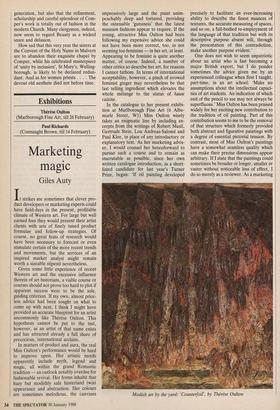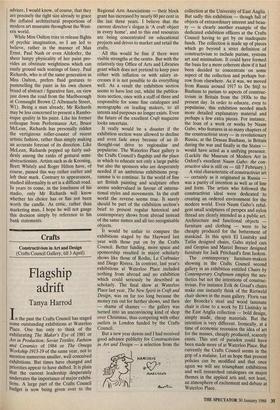Exhibitions
Therese Oulton (Marlborough Fine Art, till 26 February) Paul Richards (Connaught Brown, till 14 February)
Marketing magic
Giles Auty
It strikes me sometimes that clever pro- duct developers or marketing experts could have field-days in the present, profitable climate of Western art. For large but well earned fees they would present their artist clients with sets of finely tuned product formulae and follow-up strategies. Of course, no great feats of research would have been necessary to forecast or even stimulate certain of the more recent trends and movements, but the services of an inspired market analyst might remain worth a sizeable stipend nevertheless.
Given some little experience of recent Western art and the excessive influence therein of art historians, a viable course or courses should not prove too hard to plot if apparent success were to be the sole, guiding criterion. If my own, almost price- less advice had been sought on what to come up with next, I think I might have provided an accurate blueprint for an artist uncommonly like Th6rese Oulton. This hypothesis cannot be put to the test, however, as an artist of that name exists and has attracted already a full share of precocious, international acclaim.
In matters of product and aura, the real Miss Oulton's performance would be hard to improve upon. Her artistic motifs apparently include myth, legend and magic, all within the grand Romantic tradition — an outlook notably overdue for fashionable revival. Her forms inhabit that hazy but modishly safe hinterland twixt appearance and abstraction. Her colours are sometimes melodious, the canvases impressively large and the paint unim- peachably deep and tortured, providing the ostensible 'gutsiness' that the latest museum fashions appear to require. If the young, attractive Miss Oulton had been following my expensive advice she could not have been more correct, too, in not seeming too feminine — in her art, at least. Appearing to be feminist is quite another matter, of course. Indeed, a number of other critics so describe her art, for reasons I cannot fathom. In terms of international acceptability, however, a pinch of avowed feminist ginger may nevertheless be that last telling ingredient which elevates the whole mélange to the status of haute cuisine.
In the catalogue to her present exhibi- tion at Marlborough Fine Art (6 Albe- marle Street, W1) Miss Oulton wisely takes an enigmatic line by including ex- cerpts from the writings of Robert Musil, Gertrude Stein, Lou Andreas-Salome and Paul Klee, in place of any introductory or explanatory text. As her marketing advis- er, I would counsel her henceforward to pursue such a course and to remain as inscrutable as possible, since her own written catalogue introduction, as a short- listed candidate for last year's Turner Prize, began: 'If oil painting developed precisely to facilitate an ever-increasing ability to describe the finest nuances of textures, the accurate measuring of spaces, and so on, a full-bodied re-employment of the language of that tradition but with its descriptive purpose absent will, through the presentation of this contradiction, make another purpose evident.'
One does not wish to seem unpatriotic about an artist who is fast becoming a major British export, but I do ponder sometimes the advice given me by an experienced colleague when first I taught, part-time, in an art school: 'Make no assumptions about the intellectual capaci- ties of art students. An indication of which end of the pencil to use may not always be superfluous.' Miss Oulton has been praised widely for her exciting new contribution to the tradition of oil painting. Part of this contribution seems to me to be the removal of that structure which formerly provided both abstract and figurative paintings with a degree of essential pictorial tension. By contrast, most of Miss Oulton's paintings have a somewhat seamless quality which can make their precise dimensions appear arbitrary. If I state that the paintings could sometimes be broader or longer, smaller or vaster without noticeable loss of effect, I do so merely as a reviewer. As a marketing Modish art by the yard: 'Counterfoil', by Therese Oulton adviser, I would know, of course, that they are precisely the right size already to grace the inflated architectural proportions of modern art museums throughout the West- ern world.
While Miss Oulton tries to release flights of psychic imagination, so I am led to believe, rather in the manner of Max Ernst, Paul Nash or even Altdorfer, the sheer lumpy physicality of her paint pro- vides an obstinate weightiness which can easily ground such soarings of fancy. Paul Richards, who is of the same generation as Miss Oulton, prefers fluid gestures to pummelling the paint in his own chosen brand of abstract / figurative fare, on view just down the road from the Marlborough at Connaught Brown (2 Albemarle Street, W1). Being a man already, Mr Richards may be less concerned to present a Rambo- esque quality in his paint. Like his former colleague from Performance Art, Bruce McLean, Richards has personally ridden the vertiginous roller-coaster of recent artistic fashion, rather than simply making an accurate forecast of its direction. Like McLean, Richards popped up fairly sud- denly among the ranks of gestural semi- abstractionists. Artists such as de Kooning, Brett Whitely and Roger Hilton have, of course, passed this way rather earlier and left their mark. Contrary to appearances, studied hiformality in art is a difficult road. In years to come, in the loneliness of his studio, only Mr Richards will know whether his choice has or Has not been worth the candle. As critic, rather than marketing man, I hope he will not gauge this decision simply by reference to his bank statements.



















































 Previous page
Previous page